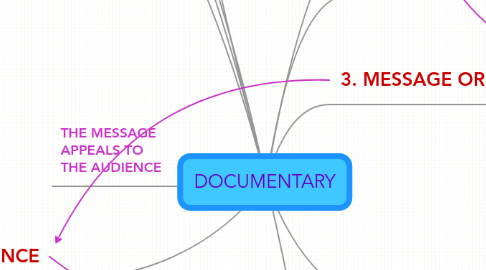
1. 4. AUDIENCE
1.1. target audience
1.1.1. age
1.1.2. gender
1.1.3. nationality
1.1.4. "Young & Rubicam's" 4 consumers
1.1.4.1. Mainstreamer
1.1.4.2. Aspirer
1.1.4.3. Succeeder
1.1.4.4. Reformer
1.1.5. occupation
1.1.6. religion
1.1.7. politics
1.1.8. education
1.1.9. race
1.2. audience appeal
1.2.1. escapism
1.2.2. personal identity
1.2.3. social relationships
1.2.4. information/learning
2. 1. MEDIA LANGUAGE
2.1. camerawork
2.1.1. camera movement
2.1.1.1. zoom
2.1.1.2. pan
2.1.1.3. track
2.1.1.4. tilt
2.1.2. shot distance
2.1.2.1. extreme close up
2.1.2.2. medium shot
2.1.2.3. long shot
2.1.2.4. extreme long shot
2.1.2.5. close up
2.2. soundtrack
2.2.1. diegetic
2.2.1.1. dialogue
2.2.2. non-diegetic
2.2.2.1. music
2.2.2.2. sound effects
2.2.2.3. voiceover
2.3. editing
2.3.1. continuity editing
2.3.2. shot-reverse shot
2.3.3. jump cuts
2.4. mise-en-scene
2.4.1. colour and lighting
2.4.2. props and settings
2.4.3. costume and make-up
2.4.4. performance and movement
2.4.4.1. facial expressions
2.4.4.2. body language
3. MEDIA LANGUAGE CREATES THE REPRESENTATION
4. THE MESSAGE APPEALS TO THE AUDIENCE
5. THE INSTITUTION NEEDS AN AUDIENCE TO WATCH
6. NARRATIVE
7. GENRE
8. 3. MESSAGE OR MEANING
8.1. what is the documentaries message?
8.2. is the documentary trying to PERSUADE us about a topic?
9. 2. REPRESENTATION
9.1. who is being represented?
9.1.1. is it FACT or OPINION?
9.2. who is creating the representations?
9.2.1. is it FACT or OPINION?
9.3. are STEREOTYPES used?
9.4. how are the they being represented (portrayed)?
9.4.1. negatively?
9.4.2. positively?
10. 5. INSTITUTION
10.1. which TV channel or Film Company?
10.2. how much money was spent?
10.3. public service
10.3.1. BBC
10.4. commercial
10.4.1. ITV
10.4.2. FOX
10.4.3. CHANNEL 5
